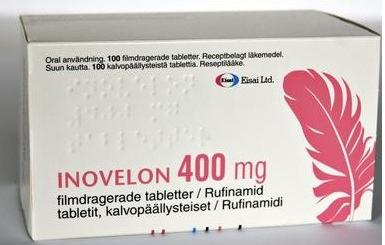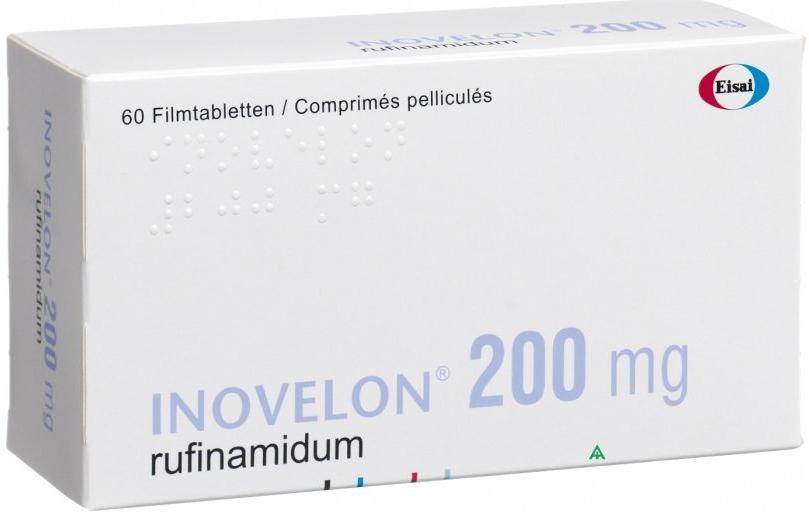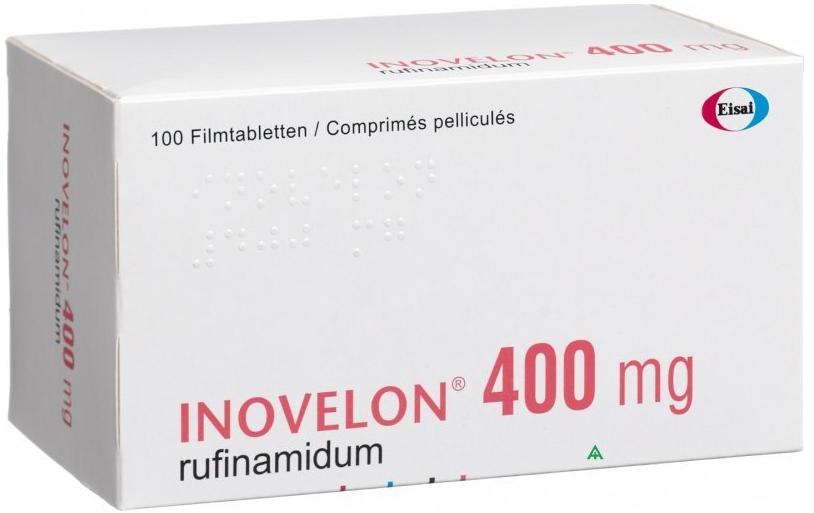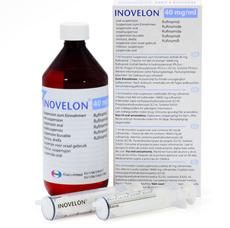|
英文药名:Inovelon(rufinamide film-coated tablets) 中文药名:卢非酰胺片 生产厂家:卫材公司
Discontinuation of treatment When rufinamide treatment is to be discontinued, it should be withdrawn gradually. In clinical trials rufinamide discontinuation was achieved by reducing the dose by approximately 25% every two days. In the case of one or more missed doses, individualised clinical judgement is necessary. Uncontrolled open-label studies suggest sustained long-term efficacy, although no controlled study has been conducted for longer than three months. Paediatric population The safety and efficacy of rufinamide of children aged 4 years and less have not yet been established. No data are available. Older people There is limited information on the use of rufinamide in older people. Since, the pharmacokinetics of rufinamide are not altered in older people (see section 5.2), dosage adjustment is not required in patients over 65 years of age. Renal impairment A study in patients with severe renal impairment indicated that no dose adjustments are required for these patients (see section 5.2). Hepatic impairment Use in patients with hepatic impairment has not been studied. Caution and careful dose titration is recommended when treating patients with mild to moderate hepatic impairment. Therefore, use in patients with severe hepatic impairment is not recommended. Method of administration Rufinamide is for oral use. It should be taken twice daily with water in the morning and in the evening, in two equally divided doses. As a food effect was observed, it will preferable to should be administered with food (see section 5.2). Film Coated Tablets If the patient has difficulty with swallowing, tablets can be crushed and administered in half a glass of water. Oral Suspension The oral suspension should be shaken vigorously before every administration. Please refer to section 6.6 for further details. 4.3 Contraindications Hypersensitivity to the active substance, triazole derivatives or to any of the excipients listed in section 6.1. 4.4 Special warnings and precautions for use Status epilepticus Status epilepticus cases have been observed during clinical development studies, under rufinamide whereas no such cases have been observed under placebo. These events led to rufinamide discontinuation in 20 % of the cases. If patients develop new seizure types and/or experience an increased frequency of status epilepticus that is different from the patient's baseline condition, then the benefit risk ratio of the therapy should be reassessed. Withdrawal of rufinamide Rufinamide should be withdrawn gradually to reduce the possibility of seizures on withdrawal. In clinical studies discontinuation was achieved by reducing the dose by approximately 25% every two days. There are insufficient data on the withdrawal of concomitant antiepileptic medicinal products once seizure control has been achieved with the addition of rufinamide. Central Nervous System reactions Rufinamide treatment has been associated with dizziness, somnolence, ataxia and gait disturbances, which could increase the occurrence of accidental falls in this population (see section 4.8). Patients and carers should exercise caution until they are familiar with the potential effects of this medicinal product. Hypersensitivity reactions Serious antiepileptic medicinal product hypersensitivity syndrome including DRESS (Drug Reaction with Eosinophilia and Systemic Symptoms) and Stevens-Johnson syndrome have occurred in association with rufinamide therapy. Signs and symptoms of this disorder were diverse; however, patients typically, although not exclusively, presented with fever and rash associated with other organ system involvement. Other associated manifestations included lymphadenopathy, liver function tests abnormalities, and haematuria. Because the disorder is variable in its expression, other organ system signs and symptoms not noted here may occur. The antiepileptic drug hypersensitivity syndrome occurred in close temporal association to the initiation of rufinamide therapy and in the paediatric population. If this reaction is suspected, rufinamide should be discontinued and alternative treatment started. All patients who develop a rash while taking rufinamide must be closely monitored. QT shortening In a thorough QT study, rufinamide produced a decrease in QTc interval proportional to concentration. Although the underlying mechanism and safety relevance of this finding is not known, clinicians should use clinical judgment when assessing whether to prescribe rufinamide to patients at risk from further shortening their QTc duration (eg. Congenital Short QT Syndrome or patients with a family history of such a syndrome). Women of childbearing potential Women of childbearing potential must use contraceptive measures during treatment with Inovelon. Physicians should try to ensure that appropriate contraception is used, and should use clinical judgement when assessing whether oral contraceptives, or the doses of the oral contraceptive components, are adequate based on the individual patients clinical situation (see section 4.5). Lactose Inovelon contains lactose, therefore patients with rare hereditary problems of galactose intolerance, the Lapp lactase deficiency or glucose-galactose malabsorption should not take this medicine. Parahydroxybenzoates, Sorbitol Inovelon oral suspension contains parahydroxybenzoates which may cause allergic reactions (possibly delayed). It also contains sorbitol and, therefore, should not be administered to patients with rare hereditary problems of fructose intolerance. Suicidal ideation Suicidal ideation and behaviour have been reported in patients treated with antiepileptic agents in several indications. A meta-analysis of randomised placebo-controlled trials of anti-epileptic medicinal products has also shown a small increased risk of suicidal ideation and behaviour. The mechanism of this risk is not known and the available data do not exclude the possibility of an increased risk for Inovelon. Therefore patients should be monitored for signs of suicidal ideation and behaviours and appropriate treatment should be considered. Patients (and caregivers of patients) should be advised to seek medical advice should signs of suicidal ideation or behaviour emerge. 4.5 Interaction with other medicinal products and other forms of interaction Potential for other medicinal products to affect rufinamide Other anti-epileptic medicinal products Rufinamide concentrations are not subject to clinically relevant changes on co-administration with known enzyme inducing antiepileptic medicinal products. For patients on rufinamide treatment who have administration of valproate initiated, significant increases in rufinamide plasma concentrations may occur. The most pronounced increases were observed in patients of low body weight (<30 kg). Therefore, consideration should be given to a dose reduction of Inovelon in patients <30 kg who are initiated on valproate therapy (see section 4.2). The addition or withdrawal of these medicinal products or adjusting of the dose of these medicinal products during rufinamide therapy may require an adjustment in dosage of rufinamide. No significant changes in rufinamide concentration are observed following co-administration with lamotrigine, topiramate or benzodiazepines. Potential for rufinamide to affect other medicinal products Other antiepileptic medicinal products The pharmacokinetic interactions between rufinamide and other antiepileptic medicinal products have been evaluated in patients with epilepsy using population pharmacokinetic modelling. Rufinamide appears not to have clinically relevant effect on carbamazepine, lamotrigine, phenobarbital, topiramate, phenytoin or valproate steady state concentrations. Oral contraceptives Co-administration of rufinamide 800mg b.i.d. and a combined oral contraceptive (ethinyloestradiol 35μg and norethindrone 1mg) for 14 days resulted in a mean decrease in the ethinyl estradiol AUC0-24 of 22% and in norethindrone AUC0-24 of 14%. Studies with other oral or implant contraceptives have not been conducted. Women of child-bearing potential using hormonal contraceptives are advised to use an additional safe and effective contraceptive method (see section 4.4 and 4.6). Cytochrome P450 enzymes Rufinamide is metabolised by hydrolysis, and is not metabolised to any notable degree by cytochrome P450 enzymes. Furthermore, rufinamide does not inhibit the activity of cytochrome P450 enzymes (see section 5.2). Thus, clinically significant interactions mediated through inhibition of cytochrome P450 system by rufinamide are unlikely to occur. Rufinamide has been shown to induce the cytochrome P450 enzyme CYP3A4 and may therefore reduce the plasma concentrations of substances which are metabolised by this enzyme. The effect was modest to moderate. The mean CYP3A activity, assessed as clearance of triazolam, was increased by 55% after 11 days of treatment with rufinamide 400 mg b.i.d. The exposure of triazolam was reduced by 36%. Higher rufinamide doses may result in a more pronounced induction. It may not be excluded that rufinamide may decrease the exposure of substances metabolized by other enzymes, or transported by transport proteins such as P-glycoprotein. It is recommended that patients treated with substances that are metabolised by the CYP3A enzyme system are to be carefully monitored for two weeks at the start of, or after the end of treatment with rufinamide, or after any marked change in the dose. A dose adjustment of the concomitantly administered medicinal product may need to be considered. These recommendations should also be considered when rufinamide is used concomitantly with substances with a narrow therapeutic window such as warfarin and digoxin. A specific interaction study in healthy subjects revealed no influence of rufinamide at a dose of 400 mg bid on the pharmacokinetics of olanzapine, a CYP1A2 substrate. No data on the interaction of rufinamide with alcohol are available. 4.6 Fertility, pregnancy and lactation Pregnancy Risk related to epilepsy and antiepileptic medicinal products in general: It has been shown that in the offspring of women with epilepsy, the prevalence of malformations is two to three times greater than the rate of approximately 3% in the general population. In the treated population, an increase in malformations has been noted with polytherapy; however, the extent to which the treatment and/or the illness is responsible has not been elucidated. Moreover, effective anti-epileptic therapy must not be interrupted, since the aggravation of the illness is detrimental to both the mother and the foetus. Risk related to rufinamide: Studies in animals revealed no teratogenic effect but foetotoxicity in presence of maternal toxicity (see section 5.3). The potential risk for humans is unknown. For rufinamide, no clinical data on exposed pregnancies are available Taking these data into consideration, rufinamide should not be used during pregnancy unless clearly necessary and in women of childbearing age not using contraceptive measures. Women of childbearing potential must use contraceptive measures during treatment with rufinamide. Physicians should try to ensure that appropriate contraception is used, and should use clinical judgement when assessing whether oral contraceptives, or the doses of the oral contraceptive components, are adequate based on the individual patients clinical situation (see section 4.5). If women treated with rufinamide plan to become pregnant, the indication of this product should be carefully weighed. During pregnancy, an effective antiepileptic rufinamide treatment must not be interrupted, since the aggravation of the illness is detrimental to both the mother and the foetus. Breast-feeding It is not known if rufinamide is excreted in human breast milk. Due to the potential harmful effects for the breast fed infant, breast-feeding should be avoided during maternal treatment with rufinamide. Fertility No data are available on the effects on fertility following treatment with rufinamide 4.7 Effects on ability to drive and use machines Inovelon may cause dizziness, somnolence and blurred vision. Depending on the individual sensitivity, rufinamide may have a mild to major influence on the ability to drive and use machines. Patients must be advised to exercise caution during activities requiring a high degree of alertness, e.g., driving or operating machinery. 4.8 Undesirable effects Summary of the safety profile The clinical development program has included over 1,900 patients, with different types of epilepsy, exposed to rufinamide. The most commonly reported adverse reactions overall were headache, dizziness, fatigue, and somnolence. The most common adverse reactions observed at a higher incidence than placebo in patients with Lennox-Gastaut syndrome were somnolence and vomiting. Adverse reactions were usually mild to moderate in severity. The discontinuation rate in Lennox-Gastaut syndrome due to adverse reactions was 8.2% for patients receiving rufinamide and 0% for patients receiving placebo. The most common adverse reactions resulting in discontinuation from the rufinamide treatment group were rash and vomiting. Tabulated list of adverse reactions Adverse reactions reported with an incidence greater than placebo, during the Lennox-Gastaut syndrome double-blind studies or in the overall rufinamide-exposed population, are listed in the table below by MedDRA preferred term, system organ class and by frequency. Frequencies are defined as: very common (≥ 1/10), common (≥ 1/100 < 1/10), uncommon (≥ 1/1,000 < 1/100), rare (≥1/10,000 to <1/1,000).
Reporting of suspected adverse reactions Reporting suspected adverse reactions after authorisation of the medicinal product is important. It allows continued monitoring of the benefit/risk balance of the medicinal product. Healthcare professionals are asked to report any suspected adverse reactions via Yellow Card Scheme Website: www.mhra.gov.uk/yellowcard 4.9 Overdose After an acute overdose, the stomach may be emptied by gastric lavage or by induction of emesis. There is no specific antidote for rufinamide. Treatment should be supportive and may include haemodialysis (see section 5.2). Multiple dosing of 7,200 mg/day was associated with no major signs or symptoms. 5. Pharmacological properties 5.1 Pharmacodynamic properties Pharmacotherapeutic group: anti-epileptics, carboxamide derivatives; ATC-code: N03AF03. Mechanism of action Rufinamide modulates the activity of sodium channels, prolonging their inactive state. Rufinamide is active in a range of animal models of epilepsy. Clinical experience Inovelon (rufinamide tablets) was administered in a double blind, placebo-controlled study, at doses of up to 45 mg/kg/day for 84 days, to 139 patients with inadequately controlled seizures associated with Lennox-Gastaut Syndrome (including both atypical absence seizures and drop attacks). Male or female patients (between 4 and 30 years of age) were included if they were being treated with 1 to 3 concomitant fixed-dose antiepileptic medicinal products. Each patient had to have at least 90 seizures in the month prior to study entry. A significant improvement was observed for all three primary variables: the percentage change in total seizure frequency per 28 days during the maintenance phase relative to baseline (-35.8% on Inovelon vs. –1.6% on placebo, p= 0.0006), the number of tonic-atonic seizures (-42.9% on Inovelon vs. 2.2% on placebo, p = 0.0002), and the seizure severity rating from the Global Evaluation performed by the parent/guardian at the end of the double-blind phase (much or very much improved in 32.2% on Inovelon vs. 14.5% on the placebo arm, p=0.0041). Population pharmacokinetic/pharmacodynamic modelling demonstrated that the reduction of total and tonic-atonic seizure frequencies, the improvement of the global evaluation of seizure severity and the increase in probability of reduction of seizure frequency were dependent on rufinamide concentrations. 5.2 Pharmacokinetic properties Absorption Maximum plasma levels are reached approximately 6 hours after administration. Peak concentration (Cmax) and plasma AUC of rufinamide increase less than proportionally with doses in both fasted and fed healthy subjects and in patients, probably due to dose-limited absorption behaviour. After single doses food increases the bioavailability (AUC) of rufinamide by approximately 34% and the peak plasma concentration by 56%. Inovelon oral suspension and Inovelon film coated tablets have been demonstrated to be bioequivalent. Distribution In in-vitro studies, only a small fraction of rufinamide (34%) was bound to human serum proteins with albumin accounting for approximately 80% of this binding. This indicates minimal risk of drug-drug interactions by displacement from binding sites during concomitant administration of other substances. Rufinamide was evenly distributed between erythrocytes and plasma. Biotransformation Rufinamide is almost exclusively eliminated by metabolism. The main pathway of metabolism is hydrolysis of the carboxylamide group to the pharmacologically inactive acid derivative CGP 47292. Cytochrome P450-mediated metabolism is very minor. The formation of small amounts of glutathione conjugates cannot be completely excluded. Rufinamide has demonstrated little or no significant capacity in-vitro to act as a competitive or mechanism-based inhibitor of the following human P450 enzymes: CYP1A2, CYP2A6, CYP2C9, CYP2C19, CYP2D6, CYP2E1, CYP3A4/5 or CYP4A9/11-2. Elimination The plasma elimination half-life is approximately 6-10 hours in healthy subjects and patients with epilepsy. When given twice daily at 12-hourly intervals, rufinamide accumulates to the extent predicted by its terminal half-life, indicating that the pharmacokinetics of rufinamide are time-independent (i.e. no autoinduction of metabolism). In a radiotracer study in three healthy volunteers, the parent compound (rufinamide) was the main radioactive component in plasma, representing about 80% of the total radioactivity, and the metabolite CGP 47292 constituting only about 15%. Renal excretion was the predominant route of elimination for active substance related material, accounting for 84.7% of the dose. Linearity/non-linearity: The bioavailability of rufinamide is dependent on dose. As dose increases the bioavailability decreases. Pharmacokinetics in special patient groups Sex Population pharmacokinetic modelling has been used to evaluate the influence of sex on the pharmacokinetics of rufinamide. Such evaluations indicate that sex does not affect the pharmacokinetics of rufinamide to a clinically relevant extent. Renal impairment The pharmacokinetics of a single 400 mg dose of rufinamide were not altered in subjects with chronic and severe renal failure compared to healthy volunteers. However, plasma levels were reduced by approximately 30% when haemodialysis was applied after administration of rufinamide, suggesting that this may be a useful procedure in case of overdose (see sections 4.2 and 4.9). Hepatic impairment No studies have been performed in patients with hepatic impairment and therefore Inovelon should not be administered to patients with severe hepatic impairment (see section 4.2). Children (2-12 years) Children generally have lower clearance of rufinamide than adults, and this difference is related to body size. Studies in new-born infants or infants and toddlers under 2 years of age have not been conducted. Older people A pharmacokinetic study in older healthy volunteers did not show a significant difference in pharmacokinetic parameters compared with younger adults. 5.3 Preclinical safety data Conventional safety pharmacology studies revealed no special hazards at clinically relevant doses. Toxicities observed in dogs at levels similar to human exposure at the maximum recommended dose were liver changes, including bile thrombi, cholestasis and liver enzyme elevations thought to be related to increased bile secretion in this species. No evidence of an associated risk was identified in the rat and monkey repeat dose toxicity studies. In reproductive and developmental toxicity studies, there were reductions in foetal growth and survival, and some stillbirths secondary to maternal toxicity. However, no effects on morphology and function, including learning or memory, were observed in the offspring. Rufinamide was not teratogenic in mice, rats or rabbits. Rufinamide was not genotoxic and had no carcinogenic potential. Adverse effects not observed in clinical studies, but seen in animals at exposure levels similar to clinical exposure levels and with possible relevance to human use was myelofibrosis of the bone marrow in the mouse carcinogenicity study. Benign bone neoplasms (osteomas) and hyperostosis seen in mice were considered a result of the activation of a mouse specific virus by fluoride ions released during the oxidative metabolism of rufinamide. Regarding the immunotoxic potential, small thymus and thymic involution were observed in dogs in a 13-week study with significant response at the high dose in male. In the 13 week study, female bone marrow and lymphoid changes are reported at the high dose with a weak incidence. In rats decreased cellularity of the bone marrow and thymic atrophy were observed only in the carcinogenicity study. 6. Pharmaceutical particulars 6.1 List of excipients Film Coated Tablet Core: Lactose monohydrate Cellulose, microcrystalline Maize starch Croscarmellose sodium Hypromellose Magnesium stearate Sodium laurilsulfate Silica colloidal, anhydrous Film coating: Hypromellose Macrogols (8000) Titanium dioxide (E171) Talc Ferric oxide red (E172) Oral suspension Microcrystalline cellulose (E460) Carmellose sodium (E466) Hydroxyethylcellulose Citric acid, anhydrous (E330) Simeticone emulsion, 30% containing benzoic acid, cyclotetrasiloxane, dimethicone, glycol stearate and glyceryl distearate, methylcellulose, PEG-40 stearate (polyethylene glycol stearate), polysorbate 65, silica gel, sorbic acid, sulphuric acid and water. Poloxamer 188 Methyl parahydroxybenzoate (E218) Propyl parahydroxybenzoate (E216) Propylene glycol (E1520). Potassium sorbate (E202) Sorbitol (E420), liquid (non-crystallising) Orange flavour Water 6.2 Incompatibilities Not applicable. 6.3 Shelf life Film Coated Tablet 4 years. Oral Suspension 3 years. After first opening: 90 days. 6.4 Special precautions for storage Film Coated Tablet Do not store above 30°C. Oral Suspension This medicinal product does not require any special storage conditions. For storage conditions after first opening of the medicinal product, see section 6.3. 6.5 Nature and contents of container Film Coated Tablets 100 mg: Aluminium/aluminium blisters, packs of 10, 30, 50, 60 and 100 film-coated tablets. 200mg: Aluminium/aluminium blisters, packs of 10, 30, 50, 60 and 100 film-coated tablets. 400 mg: Aluminium/aluminium blisters, packs of 10, 30, 50, 60, 100 and 200 film-coated tablets. Not all pack sizes may be marketed. Oral Suspension Oriented-polyethylene terephthalate (o-PET) bottle with a child-resistant polypropylene (PP) closure; each bottle contains 460 ml of suspension in an outer cardboard carton. Each carton contains one bottle, two identical calibrated oral dosing syringes and a press-in-bottle adapter (PIBA). The oral dosing syringes are graduated in 0.5 ml increments. 6.6 Special precautions for disposal and other handling Film Coated Tablets No special requirements. Oral Suspension Preparation: The press-in-bottle adapter (PIBA) which is supplied in the product carton should be inserted firmly into the neck of the bottle before use and remain in place for the duration of the usage of the bottle. The dosing syringe should be inserted into the PIBA and the dose withdrawn from the inverted bottle. The cap should be replaced after each use. The cap fits properly when the PIBA is in place. No special requirements for disposal. 7. Marketing authorisation holder Eisai Limited, Mosquito Way, Hatfield, Hertfordshire, AL10 9SN, UK 8. Marketing authorisation number(s) 100 mg 10 film-coated tablets: EU/1/06/378/001 100 mg 30 film-coated tablets: EU/1/06/378/002 100 mg 50 film-coated tablets: EU/1/06/378/003 100 mg 60 film-coated tablets: EU/1/06/378/004 100 mg 100 film-coated tablets: EU/1/06/378/005 200 mg 10 film-coated tablets: EU/1/06/378/006 200 mg 30 film-coated tablets: EU/1/06/378/007 200 mg 50 film-coated tablets: EU/1/06/378/008 200 mg 60 film-coated tablets: EU/1/06/378/009 200 mg 100 film-coated tablets: EU/1/06/378/010 400 mg 10 film-coated tablets: EU/1/06/378/011 400 mg 30 film-coated tablets: EU/1/06/378/012 400 mg 50 film-coated tablets: EU/1/06/378/013 400 mg 60 film-coated tablets: EU/1/06/378/014 400 mg 100 film-coated tablets: EU/1/06/378/015 400 mg 200 film-coated tablets: EU/1/06/378/016 40 mg/ml Oral suspension: EU/1/06/378/017 9. Date of first authorisation/renewal of the authorisation Date of first authorisation: 16 January 2007 Date of latest renewal: 16 January 2012 10. Date of revision of the text 28 June 2013 Detailed information on this product is available on the website of the European Medicines Agency http://www.ema.europa.eu. 11. Legal category POM - Medicinal product subject to medical prescription 抗癫痫新药Inovelon(rufinamide)获准在欧盟上市 欧盟人用医药产品委员会(CHMP)近期已批准日本卫材公司的抗癫痫药物Inovelon(rufinamide)上市,用于辅助治疗Lennox-Gastaut综合征所致癫痫发作的4岁以上患者。该产品的开发历程曲折,其原创公司诺华公司曾在Ⅲ期临床试验后,于2001年中断了对它的开发,并于2004年将其转让给卫材。 日本卫材公司(Eisai)的英国子公司近日接到了欧洲人用药委员会对抗癫痫药Inovelon (Rufinamide,卢非酰胺)的上市批准, 作为Lennoh-Gastaut综合征(LGS)的辅助治疗药物。LGS是一种预后不良的儿童难治性癫痫综合征,起病年龄是1~7岁。 Inovelon是一种新分子实体,作为一种广谱的抗癫痫药最先被诺华公司开发,2004年许可给卫材公司。 卫材公司目前致力于神经系统药物的开发销售,公司目前的产品包括用于治疗阿尔茨海默病的多奈哌齐(donepezil),抗癫痫药唑尼沙胺(zonisamide)。 抗癫痫药卢非酰胺(rufinamide) 介绍 瑞士诺华公司开发的卢非酰胺(rufinamide,商品名为 Banzel),此药也称为: Inovelon。于2008年11月获得FDA批准在美国上市,用于癫痫Lennox-Gastaut综合征(LGS)的辅助治疗。 卢非酰胺的中文化学名称: 1-(2, 6-二氟苯甲基)-1H-1, 2, 3-三唑-4-甲酰胺;英文化学名称: 1-[(2, 6-difluoroPHenyl)methyl]-1H-1, 2, 3-triazole-4-carboxamide。 分子式: C10H8F2N4O;相对分子质量: 238.2; CAS登记号: 106308-44-5。 文献报道卢非酰胺的合成路线是以2, 6-二氟苯甲酸为起始原料,经酯化得到2 , 6-二氟苯甲酸乙酯, 该中间体经NaBH4还原及SOCl2卤化得取代2, 6-二氟 rufinamide(Banzel) 氯苄,再与叠氮化钠反应得2, 6-二氟苄基叠氮酸酯,该叠氮酸酯与丙炔酸乙酯环合得1-(2, 6-二氟苯甲基)-1H-1, 2, 3-三唑-4-甲酸乙酯,最后经胺解得到卢非酰胺。 卢非酰胺是一种三唑类的衍生物,其化学结构与目前已经上市的抗癫痫药物不同,它是通过调节大脑钠离子通道活性而发挥作用,当浓度大于10μmol·L-1时它对单胺类、肾上腺素、组胺、乙酰胆碱、AMPA-kainate、甘氨酸、NMDA或GABA神经递质-受体系统无明显影响。药理学研究表明,卢非酰胺能有效地拮抗数种电刺激以及化学癫痫发作模型中动物的强直相及阵挛相癫痫的发作,抑制啮齿类动物最大电休克性强直2阵挛发作的口服 ED50值为5~17mg·kg-1,但对戊四唑诱导的发作疗效较差。临床研究表明,癫痫患者对卢非酰胺辅助治疗(由 400 mg增加至800、1 200、1600 mg·d-1,每周口服1次) 的耐受性良好,癫痫发作次数减少,而且对治疗耐受的局部或泛发性癫痫患者仍产生作用,它对局部癫痫发作和泛发性强直2阵挛癫痫发作的治疗也有辅助作用,可联合给药或单独给药。卢非酰胺的主要不良反应为轻微神经系统症状,表现为疲惫、困倦、嗜睡及震颤。该药对卡马西平、苯妥英或丙戊酸盐的药物代谢动力学没有影响,因此,在与其他抗癫痫药合用时不必调整卢非酰胺的剂量。 卢非酰胺的化合物专利有WO 9802423、CN 1225087、 EP 199262。同时,卢非酰胺也是欧盟批准的首个专门治疗LGS的药物。除癫痫外,卢非酰胺还正在进行针对焦虑症、双向情感障碍和神经研究。 据WHO统计,目前全球共有癫痫患者约5 000万人, 每年还出现200 万新的癫痫患者。我国癫痫患病率为 7‰,与WHO报告的发展中国家712‰的发病率接近。近几年来,世界抗癫痫药物市场份额平均年增长率为10% ,因此卢非酰胺作为抗癫痫药在我国有着巨大的市场前景。 --------------------------------------------------- 包装规格[注:以下产品不同规格和不同价格,购买经咨询为准] 片; 400mgx50 400mgx100 400mgx200
|





